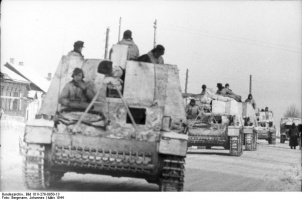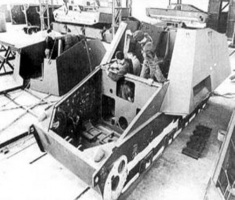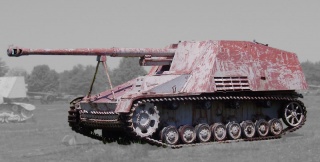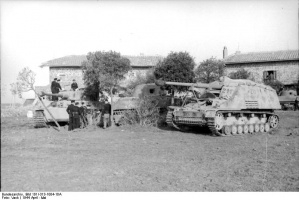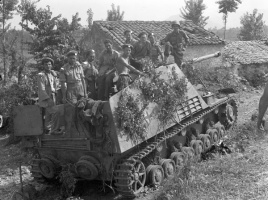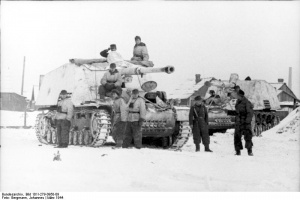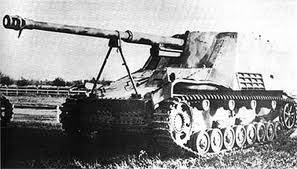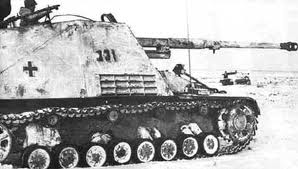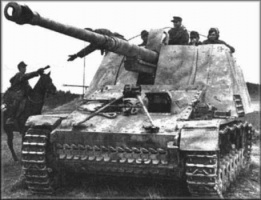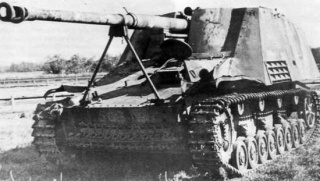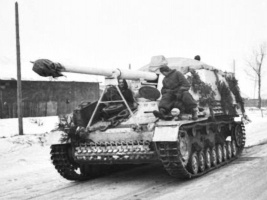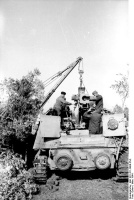Nashorn
Nashorn (Stock)
| 905000 Precio |
| 600 Puntos de impacto |
| 23.09 / 24 kgPeso |
- Comandante
| 30/20/20Blindaje del chasis(frontal/laterales/trasero, mm) |
| 15/0/10Blindaje de la torreta(frontal/laterales/trasero, mm) |
| 250 CVPotencia del motor |
| 40 km/hLímite de velocidad |
| 32 grados/sVelocidad de rotación |
| 135 Daño de proyectil estándar |
| 150 mmPerforación estándar del proyectil |
| 3.6 Tiempo en completar carga |
| 26 grados/sVelocidad de rotación torreta |
| 390 mCampo de vista |
| 400 mAlcance de radio |
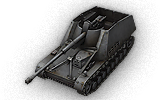
The Nashorn is a German tier 6 tank destroyer.
Initially known as the "Hornisse" (Hornet), the Nashorn was built on the basis of the Geschützwagen III/IV, and was the first German armored vehicle to mount the highly effective 8,8cm Pak 43 gun. The Nashorn proved to be a very destructive Tank Destroyer when fighting in ideal situations; i.e. from open landscapes and at a distance. The vehicle was produced from February 1943 through March 1945, with 494 built.
The Nashorn is very similar to its predecessor, the Pz.Sfl. IVc. It has an excellent view range, good mobility, and a fantastic top gun, while having very poor armor and being a relatively large, non-stealthy target. Therefore, it should be played in the same fashion as the Pz.Sfl. IVc; staying at the back line in a sniping position, supporting teammates with its superior penetration and accuracy. In the end game, its increased hit points compared to its predecessor can be very useful.
The Nashorn leads to the Sturer Emil.
Nashorn
Stock
| Nivel | Cañón | Peso (t) | Penetración media (mm) | Cadencia de tiro | Dispersión a 100 m | Tiempo de apuntamiento | ||
|---|---|---|---|---|---|---|---|---|
 |
VI | 7,5 cm Pak 42 L/70 | 1740 | 150/194/38 | 135/135/175 | 16.67 | 0.33 | 1.7 |
| Nivel | Motor | Peso (t) | Potencia del motor (c.v.) | Probabilidad de incendio tras disparo | |
|---|---|---|---|---|---|
 |
IV | Maybach HL 108 TR R | 850 | 250 | 20 |
| Nivel | Suspensión | Peso (t) | Límite de carga | Velocidad de giro (gra/s) | |
|---|---|---|---|---|---|
 |
V | Gw III und IV Ausf. A | 10000 | 24 | 32 |
| Nivel | Radio | Peso (t) | Alcance de radio (m) | |
|---|---|---|---|---|
 |
VI | Fu.Spr.Ger. "f | 0 | 400 |
Nashorn Sd.Kfz. 164
Recon
| Nivel | Cañón | Peso (t) | Penetración media (mm) | Cadencia de tiro | Dispersión a 100 m | Tiempo de apuntamiento | ||
|---|---|---|---|---|---|---|---|---|
 |
VI | 7,5 cm Pak 42 L/70 | 1740 | 150/194/38 | 135/135/175 | 16.67 | 0.33 | 1.7 |
| Nivel | Motor | Peso (t) | Potencia del motor (c.v.) | Probabilidad de incendio tras disparo | |
|---|---|---|---|---|---|
 |
IV | Maybach HL 120 TRM 112 R | 920 | 272 | 20 |
| Nivel | Suspensión | Peso (t) | Límite de carga | Velocidad de giro (gra/s) | |
|---|---|---|---|---|---|
 |
VI | Gw III und IV Ausf. B | 10000 | 27 | 36 |
| Nivel | Radio | Peso (t) | Alcance de radio (m) | |
|---|---|---|---|---|
 |
VIII | FuG 8 | 0 | 550 |
Pz.Jag Hummel
Speed
| Nivel | Cañón | Peso (t) | Penetración media (mm) | Cadencia de tiro | Dispersión a 100 m | Tiempo de apuntamiento | ||
|---|---|---|---|---|---|---|---|---|
 |
VII | 8,8 cm PaK L/56 | 2050 | 132/171/44 | 220/220/270 | 10.71 | 0.35 | 1.7 |
| Nivel | Motor | Peso (t) | Potencia del motor (c.v.) | Probabilidad de incendio tras disparo | |
|---|---|---|---|---|---|
 |
V | Maybach HL 120 TRM R | 920 | 300 | 20 |
| Nivel | Suspensión | Peso (t) | Límite de carga | Velocidad de giro (gra/s) | |
|---|---|---|---|---|---|
 |
VI | Gw III und IV Ausf. B | 10000 | 27 | 36 |
| Nivel | Radio | Peso (t) | Alcance de radio (m) | |
|---|---|---|---|---|
 |
VIII | FuG 8 | 0 | 550 |
Pz.Jag Hornisse
Attack
| Nivel | Cañón | Peso (t) | Penetración media (mm) | Cadencia de tiro | Dispersión a 100 m | Tiempo de apuntamiento | ||
|---|---|---|---|---|---|---|---|---|
 |
VIII | 8,8 cm PaK 43 L/71 | 2562 | 203/237/44 | 240/240/295 | 9.52 | 0.32 | 1.9 |
| Nivel | Motor | Peso (t) | Potencia del motor (c.v.) | Probabilidad de incendio tras disparo | |
|---|---|---|---|---|---|
 |
V | Maybach HL 120 TRM R | 920 | 300 | 20 |
| Nivel | Suspensión | Peso (t) | Límite de carga | Velocidad de giro (gra/s) | |
|---|---|---|---|---|---|
 |
VI | Gw III und IV Ausf. B | 10000 | 27 | 36 |
| Nivel | Radio | Peso (t) | Alcance de radio (m) | |
|---|---|---|---|---|
 |
VIII | FuG 8 | 0 | 550 |
Compatible Equipment
Compatible Consumables
Player Opinion
Pros and Cons
Pros:
- Excellent top gun in the 8,8cm Pak 43 L/71; essentially equal to the Jagdpanther at Tier VII
- Excellent View Range
- Decent gun arc
- Decent mobility
- Decent hit points
Cons:
- Extremely poor armour; highly susceptible to HE rounds
- Poor camouflage values
- Tall and long silhouette
- Poor gun depression
Performance
By the time you reach the Nashorn, you will be accustomed with having no armour and a powerful gun, and should know that it needs to be played as a sniper. The Nashorn loses some mobility in comparison to the Pz.Sfl.IVc, but gains hit points, having the 2nd highest hit points for a Tier VI TD.
Since it's mobility is only adequate, be extra mindful of how the battle is progressing, as your ability to relocate will take longer than with the Pz.Sfl.IVc.
Historical Info
In February 1942, the Alkett (Altmärkische Kettenwerke GmbH) arms firm of Berlin designed a tank destroyer using their recently developed Geschützwagen III/IV which as its name indicated used components of both the Panzer III and Panzer IV tank. The 8,8 cm Panzerabwehrkanone 43/1 L/71 (or shortly Pak 43/1), a long-barreled anti-tank gun more known as the main armament of the Tiger II, was mounted on the rear of the chassis complete with its gun shield and an open-topped superstructure was built up around the gun to give the crew some protection. The gun had the same traverse and elevation as if it had been on its carriage: 15° to either side and between -5° to +15° elevation. To accommodate the long and heavy gun, the hull had to be lengthened and the engine moved from the rear to the centre of the chassis. The amount of armour provided for the crew compartment was limited. The shielding provided was adequate to protect the crew from blast and small arms, but not armour piercing rounds. Thus like the Marder series weapons, the vehicle was not intended to engage in tank fights, but to provide mobility to an excellent anti-tank gun.
This model was presented for approval to Adolf Hitler in October 1942 and entered production in early 1943. It had numerous official designations, such as 8,8 cm Pak 43 (L/71) auf Fahrgestell Panzerkampfwagen III/IV (Sf) or 8,8cm Pak43 (L/71) auf Geschützwagen III/IV (Sd. Kfz. 164), though it was also known as the Panzerjäger Hornisse (in English "Tank-hunter Hornet")
During the first half of 1943, a new model of the Hornisse was introduced into production. This model altered the driver's front armour plate, along with other petty differences. This model and its predecessor, the few early production vehicles, were almost indistinguishable. It was renamed Nashorn by Hitler in 1944.
Total production of the Nashorn amounted to some 494 vehicles, most of which were built in 1943. In January 1944 Hitler favored production of a newer tank destroyer, the Jagdpanzer IV, which had a much lower silhouette, thicker frontal armor (60 mm frontal plate), and an effective though less powerful 7.5 cm gun. Though still primarily an ambush weapon, this vehicle was better built for armoured engagements. Production of the Nashorn did continue into 1945, though at a slow pace.
